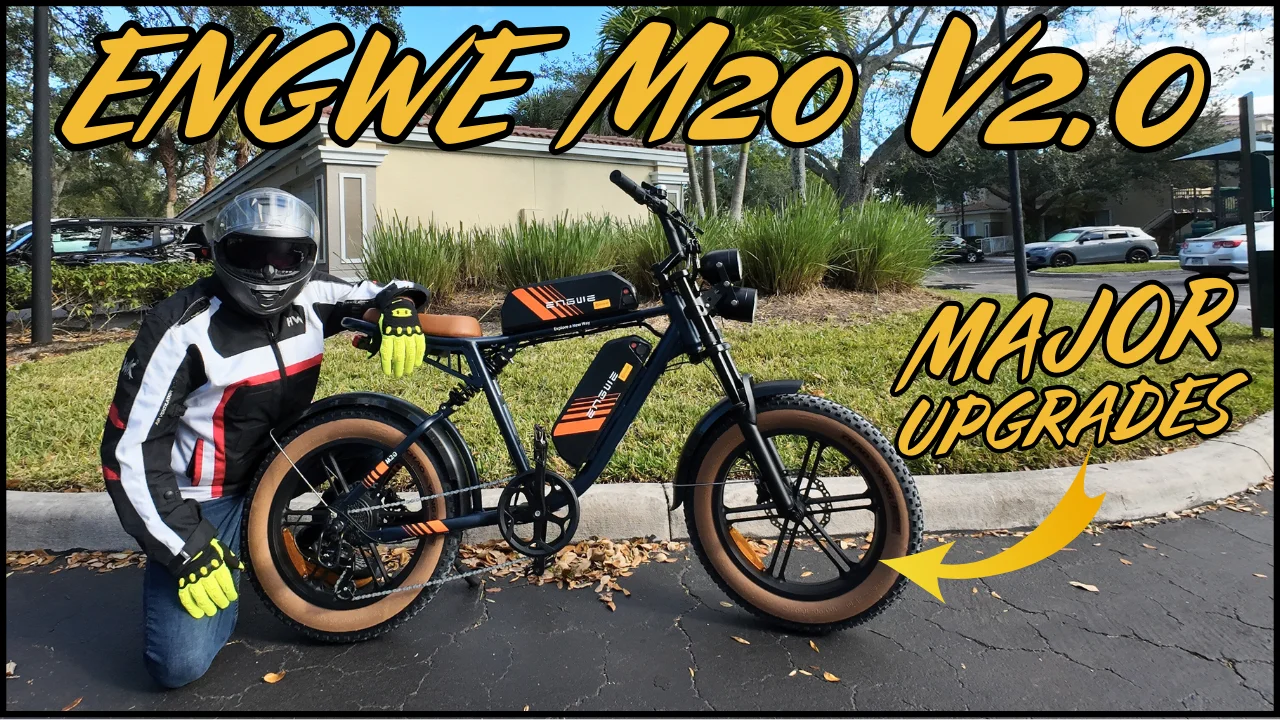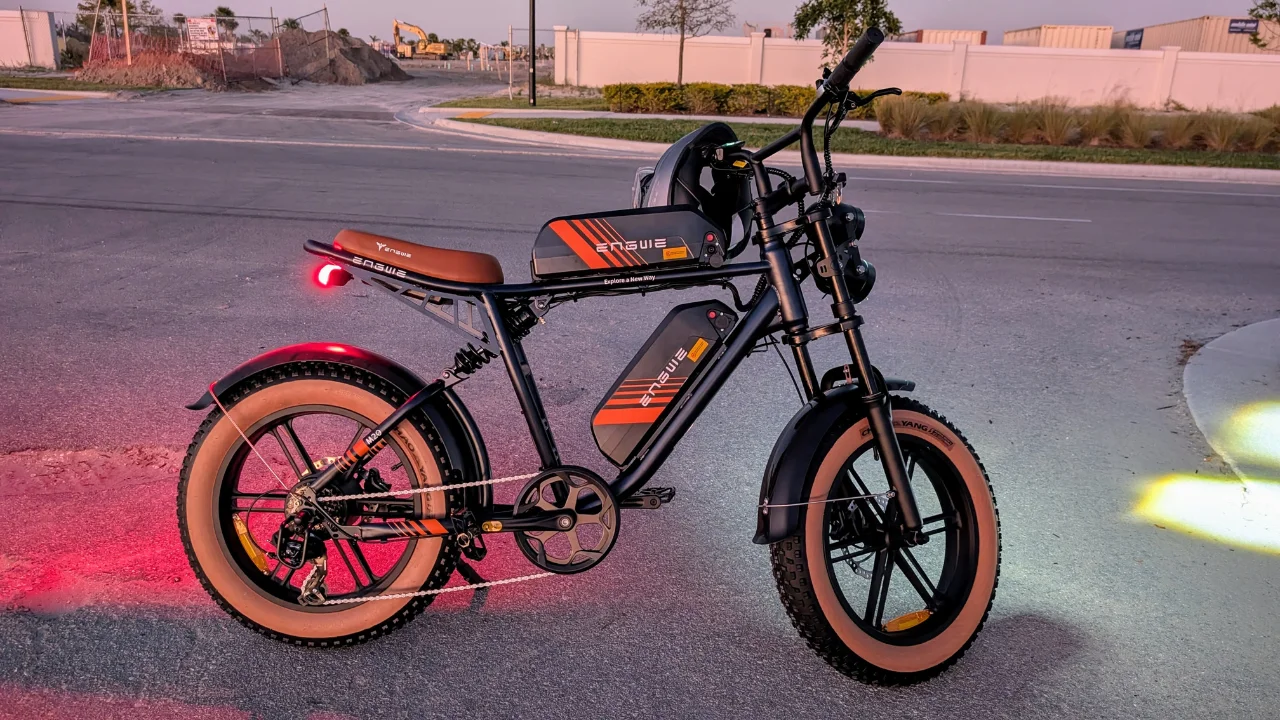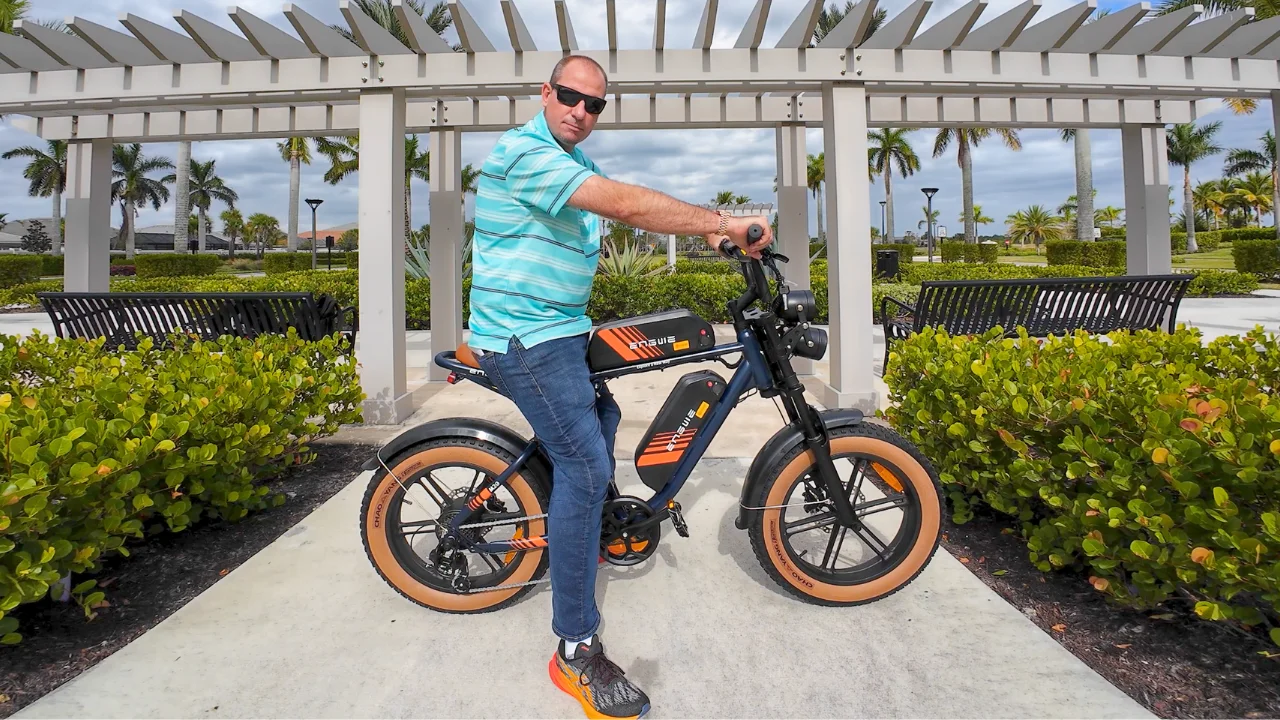Engwe M20 Version 2.0 Review
Upgrades, Performance, and Real-World Testing

Welcome back to Hobart Reviews! Today, we’re diving deep into the Engwe M20 V2.0, a feature-packed electric bike that promises significant upgrades over its predecessor, the M20 Version 1.0. We’ll explore all the differences, test its performance on the road, and help you decide whether the Version 2.0 is worth the extra investment. Buckle up as we’ll cover everything from specifications to real-world ride tests, including acceleration, braking, hill climbs, and more. Let’s get started!
Introduction: What’s New with the Engwe M20 Version 2.0?
The electric bike market is constantly evolving, and Engwe is stepping up its game with the M20 V2.0. Priced at $1,199, this new iteration brings several upgrades designed to enhance performance, comfort, and overall riding experience. But how does it stack up against the M20 Version 1.0, which is still available for $999? In this review, we’ll highlight the key differences, test its real-world performance, and help you determine whether the additional cost is justified.
Side-by-Side Comparison: M20 Version 1.0 vs. Version 2.0
| Feature | M20 Version 1.0 | M20 Version 2.0 |
|---|---|---|
| Tires & Wheels | 20”x4” Chaoyang fat tires | 20”x4” Chaoyang fat tires with tan sidewalls |
| Brakes | 160mm mechanical disc brakes | 180mm full hydraulic disc brakes |
| Rear Suspension | Fixed suspension | Adjustable air shock |
| Handlebar Stem | Flat design | Angled-up for comfort |
| Battery | 48V 13Ah (47-mile range) | 52V 15.6Ah (60-mile range) |
| Cockpit | Basic Black & White LCD display | Full Color LCD display |
| Fenders | Metal (Tend To Rattle) | Plastic (rattle-free) |
| Price | $999 | $1,199 |
The Version 2.0 adds significant improvements, particularly in braking, suspension, and battery capacity which increases the range quite a bit, making it a compelling option for riders seeking enhanced features.
Real-World Performance Tests

1. Acceleration and Top Speed
During our tests, the M20 Version 2.0 demonstrated impressive acceleration:
Throttle-only: Reached 20 mph in 9 seconds.
Pedal assist (Level 5): Hit a top speed of 29 mph on flat terrain.
The bike’s 750W motor (1200W peak) and upgraded 52 volt batteries provide ample power, though the cadence sensor and gears lead to ghost pedaling beyond 20 mph, limiting efficiency at higher speeds. One of the changes that were made in the Engwe M20 2.0 was that the throttle only gets you to 20mph while pedaling is the only way to reach the top speed of 28mph. This makes the M20 2.0 a class 3 e-bike which adheres to laws around the world.

2. Hill Climbing Ability
We put the bike through its paces on steep dirt hills, and it excelled. Near me there is a neighborhood under construction and they are digging very large lakes. This produces lots of dirt and the workers have piled up several large piles of dirt about 100ft high. I first tried to go up the hill with throttle only and was only able to reach about half way up the 100ft hill. Next I tried to get a running start and try to pedal my way up the hill. To my surprise the Engwe M20 V2.0 was able to power all the way to the top of the hill without stopping. I was thoroughly impressed by the 750 watt motor and 52 volt batteries to get all 300lbs of me and the bike up that hill! So if you live in a hilly environment you should have no problems with the Engwe M20 V2.0!

3. Off-Road Performance
Equipped with 20″ x 4″ fat tires inflated to 20 PSI and an adjustable air shock, the e-bike delivered a smooth and stable ride on gravel trails and dirt paths for the most part. I would recommend if your riding over gravel or loose rocks to keep the speed down to 10-15mph. The M20 V2.0 started to get squirely when going too fast over loose terrain. The suspension system (especially the rear air shock) effectively absorbed shocks and bumps, providing excellent comfort even when going over large gravel paths and deep ruts. The Engwe M20 V2.0 can be used off road at slower speeds but I would keep this e-bike on the road or sidewalks for the most part if I were you.

4. Braking Test
The version 1.0 had mechanical disc brakes. While they do work, having hydraulic brakes provides a better experience. Engwe decided to upgrade the version 2.0 with full hydraulic brakes and increases the disc size itself. From a speed of 21 mph, the upgraded hydraulic brakes brought the bike to a halt within approximately 30 feet. I did notice there was some minor squeaking, but so far it hasn’t gotten any worse and seems to be going away the more I ride. Overall, the braking power and responsiveness were top-notch.
5. Range Test
You can get the M20 V2.0 in either a single or dual battery configuration. Obviously the dual battery configuration will achieve better range and that is the configuration I am testing. In throttle-only mode, I covered 22.5 miles while consuming about 38% of the battery. This was a mixture of throttle and pedaling. The pedaling was mostly ghost pedaling which means I am moving my feet but not really helping the bike any. The gears don’t allow you to get any resistance once you pass around 20mph. But I was surprised on how little battery I used. This suggests the bike’s claimed 60-mile range is achievable under ideal conditions, particularly with pedal assist at slower speeds.

What We Loved (Pros)
Powerful Motor and Battery: The 52V 15.6Ah battery offers extended range and improved performance.
Upgraded Suspension: The adjustable air shock enhances comfort on rough terrain.
Enhanced Braking: Hydraulic disc brakes provide smooth and reliable stopping power.
Dual Headlights: Adjustable beams improve visibility for night rides.
Ergonomic Design: The angled-up handlebar stem ensures a comfortable riding position.
Convenient Charging: Removable batteries with charge indicators make recharging hassle-free.
Where It Falls Short (Cons)
Hard Seat: Long rides may require an aftermarket seat upgrade for better comfort.
Plastic Fenders: Less durable than the metal fenders on the Version 1.0.
Ghost Pedaling: The cadence sensor limits efficiency at high speeds.
Brake Squeaking: A minor issue that may develop over time.
FAQs
1. Should I Upgrade from the M20 Version 1.0?
If you value enhanced braking, better suspension, and a more powerful battery, the Version 2.0 is worth the investment. For budget-conscious buyers, the Version 1.0 remains a solid option.
2. How Does the Bike Handle Long Rides?
Thanks to its ergonomic handlebar stem and air suspension, the M20 Version 2.0 performs well on long rides. However, consider upgrading the seat for added comfort.
3. Is It Suitable for Beginners?
Yes, the M20 Version 2.0’s intuitive controls and stable design make it beginner-friendly.
4. Can the Engwe M20 Version 2.0 handle wet or rainy conditions?
Yes, the Engwe M20 Version 2.0 is equipped with fat tires that provide good traction on wet surfaces, and its electronic components are weather-resistant. However, prolonged exposure to heavy rain is not recommended to protect the bike’s longevity.
5. How long does it take to fully charge the battery?
The 52V 15.6Ah battery typically takes 6-8 hours to fully charge using the included charger.
6. Can the Engwe M20 Version 2.0 be used without pedaling?
Yes, the bike has a throttle-only mode, allowing you to ride without pedaling. However, this mode will reduce the overall range compared to pedal-assisted riding.
7. What is the maximum weight capacity of the bike?
The Engwe M20 Version 2.0 has a maximum weight capacity of 330 lbs (150 kg), making it suitable for a wide range of riders and cargo.
8. Is the bike suitable for taller or shorter riders?
The bike’s adjustable seat and handlebar make it versatile for riders between 5’4” and 6’4”. Taller riders may want to test it to ensure optimal comfort.
9. Does the bike have regenerative braking?
No, the Engwe M20 Version 2.0 does not feature regenerative braking. The braking system is purely mechanical and hydraulic.
10. Are replacement parts and accessories easy to find?
Yes, Engwe provides replacement parts, and many compatible accessories are available online. The customer service team can assist with any specific part inquiries.
11. Can I add a second battery to extend the range?
Yes, the bike has a dual-battery setup option. Adding a second battery can significantly extend your range, making it ideal for long-distance rides.
12. Is assembly required when the bike arrives?
Yes, the bike arrives partially assembled. You’ll need to attach components like the front wheel, handlebars, and pedals. Engwe provides a detailed manual and tools to help with the assembly process.
13. Does the Engwe M20 Version 2.0 come with a warranty?
Yes, the bike comes with a 1-year warranty covering manufacturing defects. Check the terms and conditions on the Engwe website for more details.

Final Verdict
The Engwe M20 Version 2.0 offers meaningful upgrades over its predecessor, including enhanced braking, improved suspension, and a more powerful battery. While there are minor drawbacks, such as the hard seat and ghost pedaling, the overall value is undeniable.
If you’re looking for a versatile electric bike under $1,500, the M20 Version 2.0 deserves serious consideration. To support Hobart Reviews and get your hands on this incredible e-bike, click the affiliate link below. Ride safe, and stay tuned for more in-depth reviews!
For A More In-Depth Review & Road Test Watch My Review!

About The Author
Eric “Hobart” is the founder of Hobart’s Reviews, specializing in electric scooters, e-bikes, and accessories. With over 10,000 miles ridden and more than 20 models reviewed, Hobart brings firsthand experience and expert insights to his audience. Follow his comprehensive reviews on his YouTube channel and website for trusted advice and detailed evaluations.

